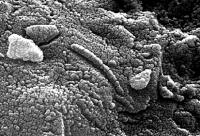Are we alone or is there life elsewhere in the universe?

Life on Mars: tracks from Opportunity probe (credit NASA / Corbis)
Everything in the way we are would change profoundly if we discovered that there is life on other celestial bodies. But how can we find out? And can we understand what kind of life would that be? And finally, how could we be sure that is really life? These problems (and questions) are not new: the ancients spoke of the "many worlds" in the universe, and in the tenth century, a Japanese folktale, The tale of the bamboo cutter, told how the Princess of the Moon's people had visited the Earth. However, when in the early seventeenth century the telescope revealed the immense size of the Universe, the search for life outside the Earth seemed a hopeless undertaking.
But then what is life? Scientists do not yet completely agree on how to define it, but in a very general sense, it can be considered as a chemical system capable of replication and that through random variation and selection becomes increasingly complex. On Earth, life requires a source of energy, water, organic molecules, elements such as carbon, oxygen, hydrogen, nitrogen, sulfur, phosphorus, and trace amounts of other elements: anywhere on Earth these requirements are met, life emerges.

Allan Hills 84001 meteorite
Meteorite internal image
Allan Hills 84001
An important indication came from the cosmos: on 27 December 1984 in the Allan Hill Antarctic glacier a 1,93 kg meteorite was found, whose chemical composition betrayed its origin from one of the oldest regions of our solar system. Apparently, 4 billion years ago the powerful impact of another meteorite had extracted it from inside Mars, at that time still a relatively young planet, on which surface it then stayed until, 15 million years ago, another meteorite blasted it in a long journey through the solar system, which then ended 13,000 years ago on the ice of Antarctica. And on 6 August 1996, the "Allan Hill 84001 Meteorite" dumbfounded the world: researchers from the U.S. space program had discovered complex organic molecules, including the base molecules of proteins inside the meteorite! What's more, they claimed that structures reminiscent of fossilized bacteria had been observed by electron microscopy. Was this proof that life existed on Mars? The shock involved even the then U.S. President Bill Clinton, who, with great fanfare, announced the momentous discovery on television.
Following other research, however, the enthusiasm somewhat subsided, as it was seen that the structures observed by electron microscopy were not really petrified bacteria, but simple mineral formations. But there were still the unequivocal complex organic molecules, evidently formed immediately after the birth of the solar system. In reality, that this was a plausible theory had already been advanced in 1952 by Stanley Miller, then a graduate student, just twenty three years old, in a legendary Lecture at the University of Chicago: for days or weeks, Miller had fired electric sparks into a gas mixture that mimicked the atmosphere of early Earth, and had produced complex organic molecules, including the molecules of proteins, the amino acids! There were many important people in the audience, and among them even Enrico Fermi: to his question tinged with skepticism "Do you know if something like this happened also on young Earth?", so Stanley Miller's supervisor, Harold C. Urey instinctively replied : "If God did not do it, well, he lost a unique opportunity."
Subsequent careful analysis later demonstrated that under conditions similar to those used by Stanley Miller, millions of different molecules formed, including even the basic components of DNA. However, the gas mixture had to be deprived of oxygen, as it was that of the early Earth, otherwise the newly formed organic molecules were destroyed by oxidative processes. The Earth's current atmosphere is made up of about one-fifth oxygen, and thus the production of complex organic molecules from simple gases would be impossible: the emergence of life as a result of the processes that were probably at work at the time of our planet's birth, today would be effectively prevented.
In our search for extraterrestrial life, for a long time we limited ourselves to observe with increasingly sophisticated telescopes the planets and moons in our solar system, study meteorites, search, with potential electromagnetic technologies, for potential intelligent signals coming from the universe, or send them with powerful antennas to the depths of the cosmos. Now, however, we send space probes in our solar system, orbiting around distant planets and moons, which analyze them with very sensitive instruments, photographing them, sometimes landing on them to study their surface and atmosphere: the data and photographs they send us are among the most beautiful and sensational that science has ever offered us. They tell us of seasons, dust storms, dried rivers on Mars, and geysers, gas eruptions, liquid methane lakes, majestic mountains, extinct volcanoes on the moons of Jupiter and Saturn. Perhaps the most important message they convey is that on many of these heavenly bodies there is enough water to make life similar to that on Earth possible. And some even have an atmosphere in which hydrogen, ethane, acetylene in the presence of energy produce methane, and thus might also provide energy for life.
None of those distant worlds is more mysterious than Titan, a moon of Saturn, where the Huygens space probe landed on 14 January 2005 and around which the spacecraft Cassini is still orbiting. These probes have shown us that Titan has not only an iron core, but also lakes of liquid methane, underground tanks with a mixture of water and ammonia, and its own atmosphere which contains mostly nitrogen and methane, but also traces of more complex molecules and so dense that men, due to the limited gravity of this moon, could fly like bats. And it is also rich in an organic brownish matter that is remarkably similar to that carried on by the meteorite Allan Hills 84001, and that Stanley Miller had found in his electrically bombarded gas mixtures. This matter is precisely what makes the atmosphere of this little moon so dense. On Titan, with temperatures of -179 degrees, it is certainly very, very cold, but the radioactivity of unstable elements could, in its inner layers, produce relatively mild temperatures. Could Titan be a cosmic alembic in which life is getting organized? Or in which some kind of life is already bursting that we do not know yet?
If we compare Mars to this wonderfully restless moon, the red planet is a venerable old cosmic body: water that once flowed abundantly solidified in the polar caps or became permafrost, and also its atmosphere of nitrogen and carbon dioxide is now sparse as the hair of an old person ... In contrast to the atmosphere of Titan, the one of Mars, however, contains a little oxygen: originating perhaps from a living thing? The underground reserves of water and relatively mild temperatures - up to -5 degrees - explain why some astrobiologists consider that there has been or there still is life on Mars. The spacecraft that landed on the red planet however, have not been able so far to prove its presence...
Even if life in our solar system were limited to the Earth, it could still be present on other planets of distant suns. These distant planets send very little light, which dims periodically during their revolutions around their suns: we can measure these very small periodic variations of light and infer from them, and other optical data, not only the timing of orbital revolutions and the mass of these planets, but also the characteristics of their atmospheres. Since the first estimates in 1992, astronomers have now discovered more than 500 exoplanets: there may be life on some of them, as their orbit around their suns at a distance that is neither too large nor too small. In particular there could be life on one of the six planets of the dwarf star Gliese 581, which is however more than 20 light years away. So that with the spacecrafts we have today we could reach it only after 800,000 years! And since according to our present knowledge no body or signal can travel at speeds exceeding that of light, we will never know with certainty if life exists so far away from us, even if it is true that the word "never" is as rare in science as the word "always" ..
The immense number of distant planets, however, speaks in favour of the existence of extraterrestrial life: if the calculations are valid according to which about one-tenth of the stars in the 125 billion galaxies known to us are surrounded by planets, we would have 6x1018 planetary systems in the universe, a figure with 18 zeros! And if even one billionth of these planets made life possible, there would still be six billion ...
Although the creation of life from chaotic matter is a hugely unlikely event, it becomes not only possible but even highly probable, if the efforts to do so are countless. And in principle it is only necessary to have a single success, just one, because life begins its triumphal march: the meteorites could then spread it in the immensity of the cosmos. But is it possible that our earthly life has come from some other celestial body? We will know it only when we compare it with extraterrestrial life. I am convinced that there is life on many planets and moons throughout the universe. Whether it is intelligent multicellular systems, single bacterial-like cells, systems with exotic chemical properties, or even non-chemical systems, for me this is not the important point. For me, the demonstration that there is life outside the Earth would be in itself the most exciting discovery of all time.


